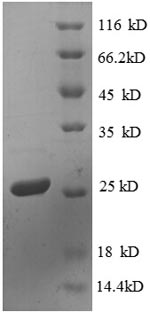Recombinant Escherichia coli 30S ribosomal protein S4 (rpsD) represents a full-length protein expressed in E. coli, spanning amino acids 2 to 206. This protein carries an N-terminal 6xHis tag for easier purification and detection. SDS-PAGE analysis indicates the product achieves greater than 90% purity, which appears to make it suitable for various research applications.
The 30S ribosomal protein S4 is a crucial component of the small ribosomal subunit in Escherichia coli. It plays what seems to be a central role in ribosome assembly and function. S4 participates in the translation process, helping to ensure accurate decoding of mRNA into proteins. Its interactions with rRNA and other ribosomal proteins may be essential for maintaining ribosomal structural integrity, making it an important focus in molecular biology and genetics research.
Potential Applications
Note: The applications listed below are based on what we know about this protein's biological functions, published research, and experience from experts in the field. However, we haven't fully tested all of these applications ourselves yet. We'd recommend running some preliminary tests first to make sure they work for your specific research goals.
Based on the provided information, recombinant E. coli rpsD is produced in its native E. coli expression system with an N-terminal 6xHis-tag, covering the full-length mature protein (2-206aa). Since rpsD is naturally expressed in E. coli, the host system contains all necessary chaperones and folding machinery, making correct folding highly probable. The 6xHis tag is relatively small and may not significantly disrupt folding, but it could potentially interfere with the N-terminal region, which might be involved in functional interactions. Purity >90% by SDS-PAGE indicates good production quality but does not confirm native folding or bioactivity, as SDS-PAGE is denaturing. No validation data (e.g., ribosome binding assays, circular dichroism) are provided. Therefore, while the protein is likely correctly folded and bioactive due to homologous expression, verification is recommended for critical applications.
1. Ribosome Assembly and Biogenesis Studies
If the recombinant rpsD is correctly folded (highly probable), it can be used to study ribosome assembly pathways, as the native expression system should support proper function. The His-tag facilitates purification and tracking but may sterically hinder interactions with 16S rRNA or other ribosomal proteins. If misfolded (unlikely but possible), assembly studies would yield inaccurate results, as rpsD may not incorporate correctly into ribosomal complexes.
2. Protein-RNA Interaction Analysis
If properly folded, the recombinant rpsD is suitable for studying binding to 16S rRNA using EMSA or surface plasmon resonance, as the native host likely preserves binding domains. However, the His-tag at the N-terminus might partially interfere with RNA binding sites, potentially affecting kinetics data. If misfolded, binding assays would not reflect biological specificity.
3. Structural and Biochemical Characterization
If correctly folded, the protein can be used for structural studies like X-ray crystallography or biophysical analyses, but the His-tag may need to be removed to avoid interference with protein surfaces or crystallization. If misfolded, structural data would misrepresent the native protein's conformation, leading to erroneous conclusions.
4. Antibody Development and Validation
This application is highly suitable, as antibody generation relies on linear epitopes, and the His-tag can be leveraged for purification and screening. Even if misfolded, antibodies may still recognize linear sequences, but they might not optimally bind conformational epitopes in native rpsD without validation.
5. Ribosome Reconstitution Experiments
If correctly folded, the recombinant rpsD can be incorporated into reconstitution systems to study 30S assembly, but the His-tag might affect integration efficiency or function. If misfolded, it would fail to support proper ribosome assembly, compromising studies on essential roles.
Final Recommendation & Action Plan
This recombinant rpsD is likely properly folded and functional due to expression in its native host, but the His-tag warrants caution for interactions-sensitive applications. Recommended actions include: verifying folding and bioactivity through circular dichroism (for secondary structure) and ribosome binding assays. For critical studies like RNA interactions or reconstitution, consider removing the His-tag via protease cleavage; use as-is for antibody development with high confidence. Always include controls to confirm activity in experiments.






